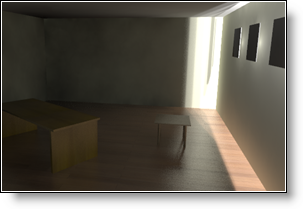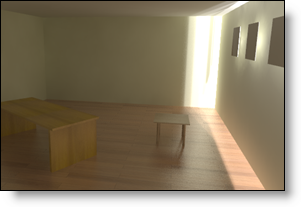|
|
-
Lighting accuracy: This cursor allows you to improve rendering quality by reducing the « noise » produced by extended lights and materials reflects. The improvement is similar to the one obtained by increasing antialiasing, but it is much faster. This setting is only on if the scene includes complex lighting that is likely to be adjusted (radiosity, sky light, extended lights).
-
Simplified Rendering: This option turns off all "costly" calculation time functions, such as non-punctual lights, material with imperfect reflection, ...
In a classic image calculation, an area that is not directly lit by light is black. In reality, this area receives light re emitted by the walls and scene objects. Global illumination takes this effect into account and avoids obtaining unlit areas.
This option is particularly useful for implementation and architecture images. (see images below).
For example, if you have several mirrors reflecting themselves one others, with a value of 1, the shadow will be reflected only in the first mirror. With a value of 2, this reflection is also be reflected in another mirror. This setting is only for beamed shadows.
-
Bottom Intensity of Beams: When a beam is reflected or refracted, part of its intensity is lost. When the intensity of a beam goes under the bottom value, this beam is no longer considered in the calculation of the image. This setting allows you to balance the duration and the accuracy of the calculation in scenes rich in reflection and/or refraction.
-
Force software rendering: In this case, the processor performs the image calculation and not the graphic card. Use this option if there is a problem with the driver of the graphic card or if the workstation processor is more powerful than its graphic card (octo-processor), where the software rendering may be faster than the hardware rendering.
-
Single bounce global illumination: This option allows you to accelerate global illumination calculation to take into account only one level of depth of the light diffusion by the scene. When this option is checked, TopSolid takes in account the diffused light by the scene, but not the diffused light by the object itself lighted by a diffused light.
This optimization is generally not a problem, except when the scene is lighted essentially by indirect lights, for example when using bracket lamps.
|

